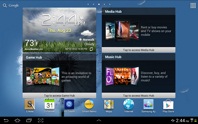Samsung Galaxy Note 10.1 Quad Core Tablet Review
Software, UI Tweaks and Camera Performance
The Galaxy Note 10.1 ships with Android ICS (Ice Cream Sandwich) v4.0.4, although we’re told a Jelly Bean update is already in the works. Android is augmented by Samsung’s TouchWiz interface, which tweaks a number of the operating system’s elements and adds a few capabilities not offered in competing devices.






Samsung Galaxy Note 10.1: Default home panels and installed apps
Out of the box, the Galaxy Note 10.1 is configured with five home panels, but that number can be increased up to seven or decreased to one with a simple pinch and a few taps. By default the main home screen is loaded up with widgets and shortcuts, which are visible in the screen-caps above. Generally speaking, we like what Samsung has done with TouchWiz and feel that its proprietary features add to the experience and outweigh some of the benefits offered by a “pure” Android experience.
There are a few additional applications loaded on the Galaxy Note 10.1 that we should point out as well. In addition to all of the Google goodness Android users expect from the mobile OS, Samsung incorporates their S-Pen Experience apps (S-Pen, S-Note, S-Planner etc.), “Multi Screen” support, Polaris Office, Adobe Photoshop Touch, Samsung Hub with a Readers Hub, Music Hub, Game Hub, and Video Hub, along with Samsung S Suggest, which is an app recommendation service.
It’s the S-Pen enhanced apps and “Multi screen” support on the Galaxy Note 10.1 that really set the device apart in the current market. The Galaxy Note 10.1’s screen is perfectly happy with finger / gesture input, but the S-Pen adds a much-appreciated level of precision. Writing notes and/or editing images is simply better when you’ve got the additional precision offered by the S-Pen.






Samsung stock widgets and Multi Screen in action
Multi Screen support is also a plus, but it’s not perfect. Samsung’s Multi Screen technology gives users the ability to open two apps, side my side for easier multi-tasking. We should note, however, that Multi Screen only works with the browser, Polaris Office, S Note, Gallery, Email app (not GMAIL), and Video player. You cannot open any two apps side by side, only the apps supported by Multi Screen. We should also point out that while two apps are available on screen, when one is active and in focus, the other—while still visible—acts as if it is in the background and inactive. When you tap from app to app, there is a noticeable lag.
In addition to Multi Screen, Samsung also allows for a handful of apps to be launched in their own windows (Alarm, Calculator, Email, Music Player, S-Note, S-Planner, and Task Manager), so in theory a user can have 10 apps on screen at once. The Note 10.1’s video player also has a floating pop-out mode, should you want a video constantly visible as well. In practice, only three apps maximum are useful, but even still, this is something Samsung offers while others do not. While not perfect, at least Samsung is innovating on the software side and trying to make tablets more conducive to productivity, not just consumption.
|






Sample shots from the Galaxy Note 10.1's rear facing, 5MP camera
The cameras on the Galaxy Note 10.1, while adequate for a tablet are nothing to write home about. In bright lighting, especially in outdoor environments, the Note 10.1’s 5MP camera can produce some nice images, but it is not a replacement for a good point-and-shoot. In lower light situations, noise is visible in the images and the camera has some issues auto-focusing. Colors seem a touch under-saturated to us and contrast could be a bit higher as well. We also found that the slow lens made capturing objects in motion with clear focus nearly impossible, but that’s also the case with every other tablet on the market as well.
|
Sample video captured with the Samsung Galaxy Note 10.1 |
Video capture was also standard fare. The Galaxy Note 10.1 is capable of playback and recording of 1080p Full HD video at 30fps (720p HD@30fps too), but the recordings are not of the best quality. For quick, in-the-moment, video recording in a pinch, the Note 10.1 will do, but it is not a replacement for a good video camera. Then again, no tablet is.






